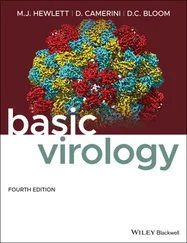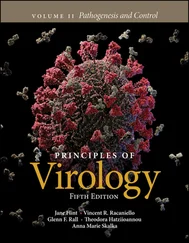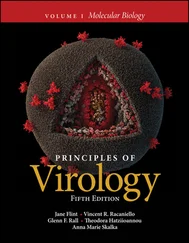Jane Flint - Principles of Virology
Здесь есть возможность читать онлайн «Jane Flint - Principles of Virology» — ознакомительный отрывок электронной книги совершенно бесплатно, а после прочтения отрывка купить полную версию. В некоторых случаях можно слушать аудио, скачать через торрент в формате fb2 и присутствует краткое содержание. Жанр: unrecognised, на английском языке. Описание произведения, (предисловие) а так же отзывы посетителей доступны на портале библиотеки ЛибКат.
- Название:Principles of Virology
- Автор:
- Жанр:
- Год:неизвестен
- ISBN:нет данных
- Рейтинг книги:3 / 5. Голосов: 1
-
Избранное:Добавить в избранное
- Отзывы:
-
Ваша оценка:
- 60
- 1
- 2
- 3
- 4
- 5
Principles of Virology: краткое содержание, описание и аннотация
Предлагаем к чтению аннотацию, описание, краткое содержание или предисловие (зависит от того, что написал сам автор книги «Principles of Virology»). Если вы не нашли необходимую информацию о книге — напишите в комментариях, мы постараемся отыскать её.
Volume I: Molecular Biology
Volume II: Pathogenesis and Control
Principles of Virology, Fifth Edition
Principles of Virology — читать онлайн ознакомительный отрывок
Ниже представлен текст книги, разбитый по страницам. Система сохранения места последней прочитанной страницы, позволяет с удобством читать онлайн бесплатно книгу «Principles of Virology», без необходимости каждый раз заново искать на чём Вы остановились. Поставьте закладку, и сможете в любой момент перейти на страницу, на которой закончили чтение.
Интервал:
Закладка:
BOX 1.7
TERMINOLOGY
The episome
In 1958, François Jacob and Elie Wollman realized that lambda prophage and the E. coli F sex factor had many common properties. This remarkable insight led to the definition of the episome.
An episome is an exogenous genetic element that is not necessary for cell survival. Its defining characteristic is the ability to reproduce in two alternative states: while integrated in the host chromosome or autonomously. However, this term is now most commonly applied to genomes that can be maintained in cells by autonomous replication and never integrate, for example, the DNA genomes of certain animal viruses.
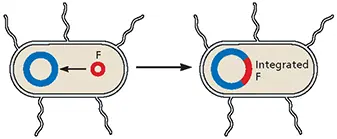
BOX 1.8
DISCUSSION
Are viruses living entities? What can/can’t they do?
Viruses can be viewed as microbes that exist in two phases: an inanimate phase, the virion; and a multiplying phase in an infected cell. Some researchers have promoted the idea that viruses are bona fide living entities. According to this notion, inanimate virions may be viewed as “spores” that transform the infected cell into a novel type of organism (termed a virocell), dedicated to the production of new virions. The nature of viruses has long been a topic of intense discussion, stimulated most recently by the discovery of giant viruses such as the mimiviruses and Pandoraviruses, which encode more functions that previously ascribed to viral genomes.
Apart from attributing “life” to viruses, many scientists have succumbed to the temptation of ascribing various actionsand motiveswhen discussing them. While remarkably effective in enlivening a lecture or an article, anthropomorphic characterizations are inaccurate and also quite misleading. Infected cells and hosts respond in many ways after virus infection, but viruses, which are totally at the mercy of their environment, lack the capacity for intentional, goal-directed activity. Therefore, viruses cannot employ, ensure, synthesize, induce, display, destroy, deploy, depend, avoid, retain, evade, exploit, generate, etc.
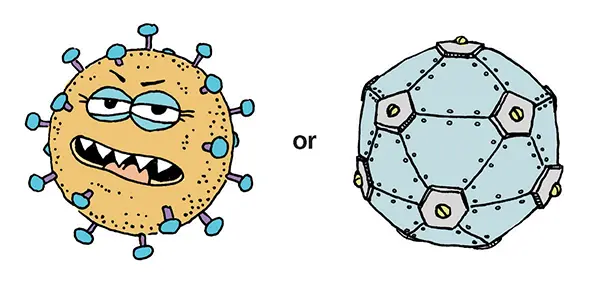
As virologists can be very passionate about their subject, it is exceedingly difficult to purge such anthropomorphic terms from virology communications. Indeed, hours were spent doing so in the preparation of this textbook, though undoubtedly there remain examples in which actions are attributed to viruses. Should you find them, let us know!
Check out what the contemporary general public feels about this topic at http://www.virology.ws/are-viruses-alive/.
Forterre P. 2016. To be or not to be alive: how recent discoveries challenge the traditional definitions of viruses and life. Stud Hist Philos Biol Biomed Sci 59:100–108.
van Regenmortel MHV. 2016. The metaphor that viruses are living is alive and well, but it is no more than a metaphor. Stud Hist Philos Biol Biomed Sci 59:117–124.
Cataloging Animal Viruses
As new viruses were being discovered and studied by electron microscopy, the virus world was seen to be a veritable zoo of particles with different sizes, shapes, and compositions. With no standard rules for naming isolates, the viral lexicon was, and still is, idiosyncratic ( Box 1.9). Constructing a rational scheme by which these agents could be classified became a subject of colorful and quite heated controversy. A traditionalist camp argued that it was impossible to infer, from the known properties of viruses, anything about their evolutionary origin or their relationships to one another—the major goal of classical taxonomy. Others maintained that despite such limitations, there were significant practical advantages in grouping viruses with similar properties. A major sticking point, however, was finding agreement on whichproperties should be considered most important in constructing a scheme for virus classification.
The Classical System
Lwoff, Robert Horne, and Paul Tournier, in 1962, advanced a comprehensive scheme for the classification of all viruses under the classical Linnaean hierarchical system consisting of phylum, class, order, family, genus, and species. Although a subsequently formed international committee on the nomenclature of viruses did not adopt this system in toto , its designation of orders, families, genera, and species is used for the classification of animal viruses.
One of the most important principles embodied in the system advanced by Lwoff and his colleagues was that viruses should be grouped according to theirshared properties rather than those of the cells or organisms they infect. A second principle was a focus on the nature of the nucleic acid genome as the primary criterion for classification. The importance of the genome had become clear when it was inferred from the Hershey-Chase experiment that viral nucleic acid alone can be infectious ( Box 1.5). Four characteristics are used in the taxonomic classification of all viruses:
BOX 1.9
TERMINOLOGY
Complexities of viral nomenclature
No consistent system for naming viral isolates has been established by their discoverers. For example, among the vertebrate viruses, some are named for the associated diseases (e.g., poliovirus, rabies virus), for the specific type of disease they cause (e.g., murine leukemia virus), or for the sites in the body that are affected or from which they were first isolated (e.g., rhinovirus and adenovirus). Others are named for the geographic locations from which they were first isolated (e.g., Sendai virus [Sendai, Japan] and Coxsackievirus [Coxsackie, NY]) or for the scientists who first discovered them (e.g., Epstein-Barr virus). In these cases, the virus names are capitalized. Some viruses are even named for the way in which people imagined they were contracted (e.g., influenza, for the “influence” of bad air), how they were first perceived (e.g., the giant mimiviruses [ Box 1.10], for the fact that they “mimic” bacteria), or totally by whimsy (e.g., Pandoravirus, after Pandora’s jar [later box] of Greek mythology). Finally, combinations of the above designations are also used (e.g., Rous sarcoma virus).
1 Nature of the nucleic acid in the virus particle (DNA or RNA)
2 Symmetry of the protein shell ( capsid)
3 Presence or absence of a lipid membrane ( envelope)
4 Dimensions of the virion and capsid
The elucidation of evolutionary relationships by analyses of nucleic acid and protein sequence similarities is now thestandard method for assigning viruses to a particular family and ordering members within a family. For example, hepatitis C virus was classified as a member of the family Flaviviridae and MERS was assigned to the Coronaviridae based on their genome sequences. However, as our knowledge of molecular properties of viruses and their reproduction has increased, other relationships have become apparent. Hepadnaviridae , Retroviridae , and some plant viruses are classified as different families on the basis of the nature of their genomes. Nevertheless, they are all related by the fact that reverse transcription is an essential step in their reproductive cycles, and the viral polymerases that perform this task exhibit important similarities in amino acid sequence. Another example is the classification of the giant protozoan Mimiviridae as members of a related group called nucleocytoplasmic large DNA viruses (NCLDVs), which includes the Poxviridae that infect vertebrates ( Box 1.10).
Читать дальшеИнтервал:
Закладка:
Похожие книги на «Principles of Virology»
Представляем Вашему вниманию похожие книги на «Principles of Virology» списком для выбора. Мы отобрали схожую по названию и смыслу литературу в надежде предоставить читателям больше вариантов отыскать новые, интересные, ещё непрочитанные произведения.
Обсуждение, отзывы о книге «Principles of Virology» и просто собственные мнения читателей. Оставьте ваши комментарии, напишите, что Вы думаете о произведении, его смысле или главных героях. Укажите что конкретно понравилось, а что нет, и почему Вы так считаете.





